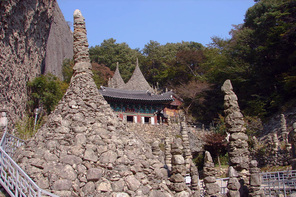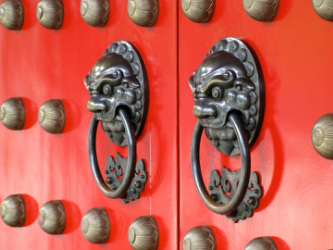
Image Courtesy of: http://commons.wikimedia.org
I find it difficult to describe the Paryongsan Stone Pagodas. Upon passing between the two big stone pagodas that stand on either side of the stream and trail, one gradually realizes the great expanse and diversity of the pagodas. They are small, large, every other size, and they are everywhere. Anywhere you look they are there amid the trees: stone fingers reaching up, in the same spirit that the trees reach up. Reaching up to what, no one can see; reaching up for what no one can know; reaching up just to reach, as if to express some unsayable yearning.

Image Courtesy of: http://www.fotopedia.com/
I recently visited the Korea National Museum in Seoul There are a lot of pieces I like in the metals room. There are some hinges that I adore. They are inlaid with different metals in a curving pattern. What I like so much is the attention and craft that went into something that was probably mostly utilitarian and ignored. When was the last time that you took a particular notice of the hinges on a door you opened? These door pulls speak to me in the same way. Perhaps, these door pulls had a reason to be a little more decorative. Maybe they were part of a palace or an important temple. But it’s possible they were largely ignored, and lost in the view of greater things. Still, a great deal of attention and craft was given to something that had a very humble task. There is something about the importance of small things that speaks to me. Maybe it is because I see a correlation with slow travel. When I take the time to see and appreciate details, no matter how small, my journey is enhanced.
I am here for a day of hiking on Palgong Mountain and to visit Donghwa Temple, but when I get off the bus about an hour outside of Daegu, I am temporarily paralyzed by the homogeneity of Korea. I am in a mountain village, that is the gateway to the mountains and the temple. And I immediately have the sense of being here before. I could swear that I have seen the plaza that is just ahead of me; the restaurants and shops, too, itch at my memory, and even their placement seems familiar. The public bathrooms, likewise. Yet, I am pretty sure I’ve never been here. I start up the road to the temple, and a huge gate adorned with banners dominates the road. The feeling of having been here before passes. I know I haven’t seen this.
Buddha’s Birthday started for me at midnight; that is, I never went to sleep. I had intended to, but by the time I was going to get into bed it was already 11:30 P.M., and I wasn’t tired at all. At 1:00 A.M. I was on my bicycle on my way to the temple. Seonjusa is located about six miles away on the opposite side of the city that I live in. I had planned on taking my scooter, but earlier I’d found out the battery was dead. The weather was perfect for the bicycle ride. Most of the way I used the seperated bike lanes that are available in Korea. My goal was to be at the temple before morning prayers started, but I didn’t know exactly when that was. I arrived at the temple at 2:00 A.M. It had taken just under an hour to ride the six miles. In the main courtyard, paper lanterns glowed and flickered. From time to time flaming hot wax fell to the ground from the candles inside the lanterns. It was at once a joyful and calming sight. One of the monks was up and sitting taking in the sight was well. He was very pleased to see me, and took an immediate interest in me. He had some English and tried to tell me various things that didn’t all translate well. For the most part I thought I could understand an approximation of his intentions, but who knows for certain, and, really, who cares? It was a beautiful experience no matter what was said, and I felt very welcome.
I can not decide what in Korea is more beautiful: cherry blossoms in spring or the annual Lotus Lantern Parade in Seoul. I love this parade. (And I’m not using the “L” word lightly here.) The lanterns and the floats are beautiful. It’s hard for me to describe how much so; I would use the word ‘luminous’, but only with offering a wink at the same time. The beauty of seeing over 100,000 lanterns is not the only reason to fall in love with this parade, though. Of course, there is the novelty of it. A parade like this is an unusual event for someone who grew up in the United States. I like the pace of it, too. It is a near constant, meandering stroll of thousands of people in colorful clothes walking by with lanterns. It is a people watchers dream. There is some music, but more than the music I love the chanting as different groups of monks walk past.


 RSS Feed
RSS Feed